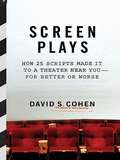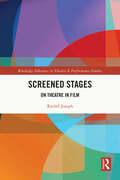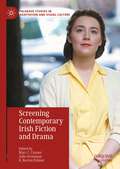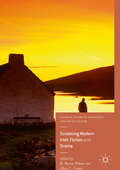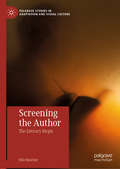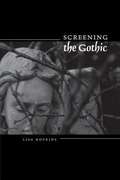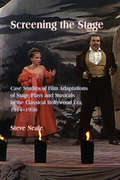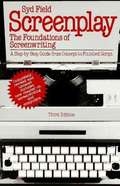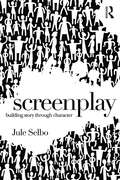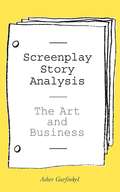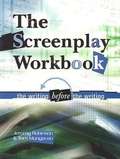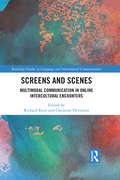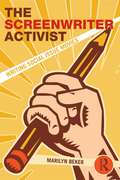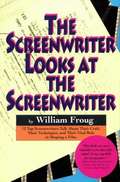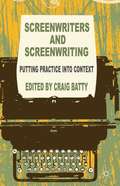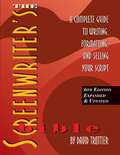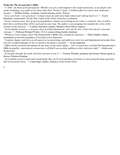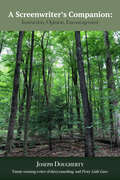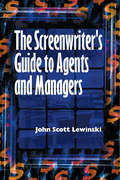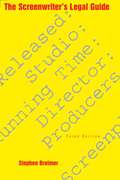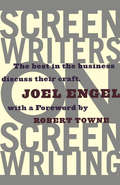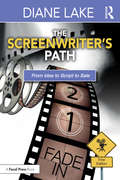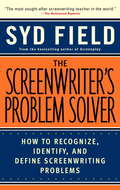- Table View
- List View
Screen Plays: How 25 Scripts Made It to a Theater Near You--for Better or Worse
by David S. CohenIn this fascinating survey of contemporary screen craft, David Cohen of Script and Variety magazines leads readers down the long and harrowing road every screenplay takes from idea to script to screen. In interviews with Hollywood screenwriters from across the board-Oscar winners and novices alike-Cohen explores what sets apart the blockbuster successes from the downright disasters. Tracing the fortunes of twenty-five films, including Troy, Erin Brockovich, Lost in Translation, and The Aviator, Cohen offers insider access to back lots and boardrooms, to studio heads, directors, and to the over-caffeinated screenwriters themselves. As the story of each film evolves from the drawing board to the big screen, Cohen proves that how a script is written, sold, developed, and filmed can be just as dramatic and intriguing as the movie itself-especially when the resulting movie is a fiasco. Covering films of all kinds-from tongue-in-cheek romps like John Waters's A Dirty Shame to Oscar winners like Monster's Ball and The Hours-Screen Plays is an anecdote-filled, often inspiring, always revealing look at the alchemy of the movie business. With Cohen as your expert guide, Screen Plays exposes how and why certain films (such as Gladiator) become "tent poles," those runaway successes every studio needs to survive, and others become train wrecks. Full of critical clues on how to sell a script-and avoid seeing it destroyed before the director calls Action!-it's the one book every aspiring screenwriter will find irresistible.
Screened Stages: On Theatre in Film (ISSN)
by Rachel JosephThis book is devoted to tracing the variety of ways that theatre, theatricality, and performance are embedded in Hollywood cinema as screened stages.A screened stage is the literal or metaphorical appearance of a stage on screen. When the Hollywood style emerged in cinema history it traumatically severed the entwined relationship between film and theatre. The book makes the argument that cinema longs for theatre after that separation. The histories of stage and screen persistently crisscross one another making their separation problematic. The screened stage from the end of the nineteenth century until now offers a miniaturized version of cinema and theatre history. Moments of the stage within the screen compress historical styles and movements into saturated representations on film. Such examples overflow the cinematic screen into singular manifestations of presentness. Screened stages uncover what it means to be simultaneously present and absent.This book would be of great interest to students and scholars of theatre, film, dance, and performance.
Screening Contemporary Irish Fiction and Drama (Palgrave Studies in Adaptation and Visual Culture)
by Marc C. Conner Julie Grossman R. Barton PalmerIn this book, each chapter explores significant Irish texts in their literary, cultural, and historical contexts. With an introduction that establishes the multiple critical contexts for Irish cinema, literature, and their adaptive textual worlds, the volume addresses some of the most popular and important late 20th-Century and 21st Century works that have had an impact on the Irish and global cinema and literary landscape. A remarkable series of acclaimed and profitable domestic productions during the past three decades has accompanied, while chronicling, Ireland’s struggle with self-identity, national consciousness, and cultural expression, such that the story of contemporary Irish cinema is in many ways the story of the young nation’s growth pains and travails. Whereas Irish literature had long stood as the nation’s foremost artistic achievement, it is not too much to say that film now rivals literature as Ireland’s key form of cultural expression. The proliferation of successful screen versionings of Irish fiction and drama shows how intimately the contemporary Irish cinema is tied to the project of both understanding and complicating (even denying) a national identity that has undergone radical change during the past three decades. This present volume is the first to present a collective accounting of that productive synergy, which has seen so much of contemporary Irish literature transferred to the screen.
Screening Early Modern Drama
by Pascale AebischerWhile film adaptations of Shakespeare's plays captured the popular imagination at the turn of the last century, independent filmmakers began to adapt the plays of Shakespeare's contemporaries. The roots of their films in European avant-garde cinema and the plays' politically subversive, sexually transgressive and violent subject matter challenge Shakespeare's cultural dominance and the conventions of mainstream cinema. In Screening Early Modern Drama, Pascale Aebischer shows how director Derek Jarman constructed an alternative, dissident, approach to filming literary heritage in his 'queer' Caravaggio and Edward II, providing models for subsequent filmmakers such as Mike Figgis, Peter Greenaway, Alex Cox and Sarah Harding. Aebischer explains how the advent of digital video has led to an explosion in low-budget screen versions of early modern drama. The only comprehensive analysis of early modern drama on screen to date, this groundbreaking study also includes an extensive annotated filmography listing forty-eight surviving adaptations.
Screening Modern Irish Fiction and Drama
by Marc C. Conner R. Barton PalmerThis book offers the first comprehensive discussion of the relationship between Modern Irish Literature and the Irish cinema, with twelve chapters written by experts in the field that deal with principal films, authors, and directors. This survey outlines the influence of screen adaptation of important texts from the national literature on the construction of an Irish cinema, many of whose films because of cultural constraints were produced and exhibited outside the country until very recently. Authors discussed include George Bernard Shaw, Oscar Wilde, Liam O'Flaherty, Christy Brown, Edna O'Brien, James Joyce, and Brian Friel. The films analysed in this volume include THE QUIET MAN, THE INFORMER, MAJOR BARBARA, THE GIRL WITH GREEN EYES, MY LEFT FOOT, THE PICTURE OF DORIAN GRAY, THE SNAPPER, and DANCING AT LUGHNASA. The introduction features a detailed discussion of the cultural and political questions raised by the promotion of forms of national identity by Ireland's literary and cinematic establishments.
Screening the Author: The Literary Biopic (Palgrave Studies in Adaptation and Visual Culture)
by Hila ShacharThis book is the first comprehensive analysis of the contemporary representation of the author on screen. It does this through two main approaches: by looking at how biographies of well-known authors in Western culture have been adapted onto the film and television screen; and by examining the wider preoccupation with the idea of what the ‘author persona’ means in broader economic, cultural, industrial, and ideological terms. Drawing from current debates about the uses of the heritage industry and conventions of the Hollywood biopic and celebrity culture, this book re-frames the analysis of the author on screen in contemporary culture and theorises it under its own unique genre: the ‘literary biopic’. With case studies including adaptations of the biographies and cultural personas of William Shakespeare, Jane Austen, Oscar Wilde, Sylvia Plath, Virginia Woolf, and Allen Ginsberg—to name a few–this book examines how and why the author continues to be a prominent screen and cultural preoccupation.
Screening the Gothic
by Lisa HopkinsFilmmakers have long been drawn to the Gothic with its eerie settings and promise of horror lurking beneath the surface. Moreover, the Gothic allows filmmakers to hold a mirror up to their own age and reveal society's deepest fears. Franco Zeffirelli's Jane Eyre, Francis Ford Coppola's Bram Stoker's Dracula, and Kenneth Branagh's Hamlet are just a few examples of film adaptations of literary Gothic texts. In this ground-breaking study, Lisa Hopkins explores how the Gothic has been deployed in these and other contemporary films and comes to some surprising conclusions. For instance, in a brilliant chapter on films geared to children, Hopkins finds that horror resides not in the trolls, wizards, and goblins that abound in Harry Potter, but in the heart of the family. <P><P> Screening the Gothic offers a radical new way of understanding the relationship between film and the Gothic as it surveys a wide range of films, many of which have received scant critical attention. Its central claim is that, paradoxically, those texts whose affiliations with the Gothic were the clearest became the least Gothic when filmed. Thus, Hopkins surprises readers by revealing Gothic elements in films such as Sense and Sensibility and Mansfield Park, as well as exploring more obviously Gothic films like The Mummy and The Fellowship of the Ring. Written in an accessible and engaging manner, Screening the Gothic will be of interest to film lovers as well as students and scholars.
Screening the Stage: Case Studies of Film Adaptations of Stage Plays and Musicals in the Classical Hollywood Era, 1914-1956
by Steven NealeIntroduced by a comprehensive account of the factors governing the adaptation of stage plays and musicals in Hollywood from the early 1910s to the mid-to-late 1950s, Screening the Stage consists of a series of chapter-length studies of feature-length films, the plays and musicals on which they were based, and their remakes where pertinent. Founded on an awareness of evolving technologies and industrial practices rather than the tenets of adaptation theory, particular attention is paid to the evolving practices of Hollywood as well as to the purport and structure of the plays and stage musicals on which the film versions were based. Each play or musical is contextualized and summarized in detail, and each film is analyzed so as to pinpoint the ways in which they articulate, modify, or rework the former. Examples range from dramas, comedies, melodramas, musicals, operettas, thrillers, westerns and war film, and include The Squaw Man, The Poor Little Rich Girl, The Merry Widow, 7th Heaven, The Cocoanuts, Waterloo Bridge, Stage Door, I Remember Mama, The Pirate, Dial M for Murder and Attack.
Screenplay: The Foundations of Screenwriting (Third Edition)
by Syd FieldHere are easily understood guidelines to make film writing accessible to novices and to help practiced writers improve their scripts. Syd Field pinpoints the structural and stylistic elements essential to every good screenplay. He presents a step-by-step, comprehensive technique for writing the script that will succeed. Why are the first ten pages of your script crucially important? How do you collaborate successfully with someone else? How do you adapt a novel, a play, or an article into a screenplay? How do you market your script?
Screenplay: Building Story Through Character
by Jule SelboScreenplay: Building Story Through Character is designed to help screenwriters turn simple or intricate ideas into exciting, multidimensional film narratives with fully-realized characters. Based on Jule Selbo’s unique 11-step structure for building story through characters, the book teaches budding screenwriters the skills to focus and shape their ideas, turning them into stories filled with character development, strong plot elements based on obstacles and conflicts, and multifaceted emotional arcs. Using examples and analysis from classic and contemporary films across a range of genres, from The Godfather to Guardians of the Galaxy, Selbo’s Screenplay takes students inside the scriptwriting process, providing a broad overview for both beginners and seasoned writers alike. The book is rounded out with discussion questions, writing exercises, a guide to the business of screenwriting, in-depth film breakdowns, and a glossary of screenwriting terms.
Screenplay Story Analysis: The Art And Business
by Asher GarfinkelSometimes it seems like everybody's writing a screenplay. But who reads those screenplays? Professional story analysts, that's who. Screenplay Story Analysis explains exactly how to become a professional story analyst.<P><P> Along with a basic how-to on writing a story analysis-or "coverage"-this book explains the techniques and thought processes involved in reading and evaluating a screenplay. Get familiar with terms, techniques, and general story elements. Master standard coverage format and content. Find guidelines for practicing coverage and getting work as a professional story analyst. With a foreword by Craig Perry, producer of American Pie, Final Destination, and other successful movies, and quotes from industry pros from top entertainment companies including ABC and Paramount Pictures, this is the essential guide for breaking into the business.
The Screenplay Workbook: The Writing Before the Writing
by Jeremy Robinson Tom MungovanThis perforated-page workbook for students learning to write screenplays includes numerous worksheets, charts, and fill-in lists designed to help students focus on essential aspects of the screenplay. Worksheets are provided for concept creation, character development and relationships, plot structure, plot points, character arc, and scenes. Online resources are listed and described. The authors are screenplay writers. Annotation (c)2003 Book News, Inc. , Portland, OR (booknews. com)
Screens and Scenes: Multimodal Communication in Online Intercultural Encounters (Routledge Studies in Language and Intercultural Communication)
by Richard Kern Christine DevelotteThis book examines the relationships between online visual interfaces and language use in educational contexts and the features that underpin them to explore the complex nature of online communication and its implications for educational practice. Adopting a case study approach featuring a global range of examples, the volume uniquely focuses on multimodal intercultural interactions, with a particular interest in videoconferencing, to look at how they project and reflect particular cultural values and tendencies concerning language use and how they elucidate the complex cultural identifications and affiliations inherent in intercultural encounters. The book employs a diverse range of theoretical and research frameworks to highlight the dynamic connections between digital technology, social life, and language use, and the ways in which they can inform language education, making this an ideal resource for students and scholars in applied linguistics, communication studies, media studies, information studies, and education.
The Screenwriter Activist: Writing Social Issue Movies
by Marilyn BekerHotel Rwanda. Philadelphia. Silkwood. Some of the most important films ever made have tackled real-world social issues, from genocide to homophobia to corporate greed. As storytellers, activist screenwriters recognize that social issues make great stories that can be gut-wrenching, heart-tugging, funny, tragic, and interesting to watch. The Screenwriter Activist helps screenwriters tell those stories in compelling, non-preachy, and inspiring ways. The Screenwriter Activist is an in-depth, practical guide, appropriate for students in intermediate or graduate screenwriting courses in Film and English Programs as well as professionals who want to write a movie that can make a difference in the world. Using examples from classic and recent popular films, The Screenwriter Activist: Explores the motivation and sensibility a screenwriter needs to embark on a social issue project Gives techniques for choosing compelling subjects Provides historical context for social issue movies Explains how characters legitimize social issue themes Puts forward specific models for structuring advocacy screenplays Lays out a roadmap for how screenwriters can get a social issue movie made If you care deeply about social issues and recognize that films can be highly effective platforms for motivativng audiences to civic involvement and social action, this is the one screenwriting book you need to read.
The Screenwriter Looks at the Screenwriter
by William FrougTwelve of Hollywood's top screenwriters discuss their craft and their lives, including: Johnson 'Grapes of Wrath', Diamond 'Some Like It Hot', Henry 'The Graduate', and Lardner 'M*A*S*H'.
The Screenwriter Within: How to Turn the Movie in Your Head into a Salable Screenplay
by D. B. GillesIf you've ever dreamed of writing a screenplay,The Screenwriter Withinis the book for you. Insightful, inspirational, and wildly irreverent, it takes you through all the stages of the writing process, using references to hit movies and the author's personal experience to show you how to: Turn everyday events into big-screen successes Find the best stories to turn into screenplays Develop strong characters Write compelling dialogue Find your niche as a screenwriter . . . and much more.
Screenwriters and Screenwriting
by Craig BattyScreenwriters and Screenwriting is an innovative, fresh and lively book that is useful for both screenwriting practice and academic study. It is international in scope, with case studies and analyses from the US, the UK, Australia, Japan, Ireland and Denmark. The book presents a distinctive collection of chapters from creative academics and critical practitioners that serve one purpose: to put aspects of screenwriting practice into their relevant contexts. Focusing on how screenplays are written, developed and received, the contributors challenge assumptions of what 'screenwriting studies' might be, and celebrates the role of the screenwriter in the creation of a screenplay. It is intended to be thought provoking and stimulating, with the ultimate aim of inspiring current and future screenwriting practitioners and scholars.
The Screenwriter's Bible: A Complete Guide To Writing, Formatting, And Selling Your Script
by David TrottierThe Bible is five books bound into a single volume. -- a screenwriting primer (provides a concise presentation of screenwriting basics) -- a formatting guide (presents both correct screenplay and teleplay formats) -- a screenwriting workbook (the writing process, from nascent ideas to revisions) -- a sales and marketing guide (offers a marketing plan and sales strategies) -- a resource guide (provides contacts for industry organizations, guilds and unions, schools, publications, support groups and services, contests, etc.)
The Screenwriter's Bible: A Complete Guide to Writing, Formatting, and Selling Your Script
by David TrottierThe Screenwriter s Bible's 7th edition marks the 25th anniversary of one of the most popular, authoritative, and useful books on screenwriting. A standard by which other screenwriting books are measured, it has sold over 340,000 copies in its 25-year life. Always up-to-date and reliable, it contains everything that both the budding and working screenwriter need under one cover five books in one!
A Screenwriter's Companion: Instruction, Opinion, Encouragement
by Joseph Dougherty Scott Ryan“I was a writer before I knew what a writer was.” -Joseph DoughertyJoseph Dougherty has been a successful playwright and television writer, producer, and director for more than thirty years. He's written for breakthrough series that have changed the way we look at television drama, from thirtysomething to Pretty Little Liars, winning everything from Emmys to Teen Choice Awards along the way.In A Screenwriter's Companion, Dougherty offers insights and advice both practical and nonpractical to writers and would-be writers. Dougherty's voice comes off the page with anecdotes about the writing process, hard-learned tips for survival in “the business,” and reflections on the influences that head led him to a successful career. Honestly, entertainingly, without cynicism, he gives readers permission to embrace the writer they want to be, so they can experience the rewards and satisfactions of writing. Beyond an insider's take on story and structure, dialogue, action and outlining, A Screenwriter's Companion is as much mentor as it is manual. With every insider observation about how to keep a potential producer reading till the last page of a script, there's encouragement to explore your thoughts and memories, things a writer needs to embrace in order to become more than “a pro.” In short, to see writing not as merely a career, but as a way to greater self-understanding.
The Screenwriter's Guide to Agents and Managers
by John Scott LewinskiThe lessons to be learned from this helpful guide show aspiring screenwriters, television writers, and novelists how to catch an agent's eye and develop a successful scriptwriting career. Step-by-step instructions reveal how to get around the "Catch 22" of the trade-that you can't get an agent until you've sold a script. Interviews with prominent agents and managers disclose how the power brokers choose material, what kinds of writers command their attention, and what they expect from the writers they sign on. Tips on how to write a winning spec script, how to word an effective query letter, how to forge a sound relationship with reps, and other invaluable advice fill this insider's guide.
The Screenwriter's Legal Guide: Third Edition
by Stephen BreimerThis authoritative guide will help both fledgling and established writers to negotiate the best deal, protect their work, and get fair compensation for it. One of the most powerful entertainment lawyers in Hollywood provides easy-to-understand, expert advice on all the legal issues involved in the business of screenwriting. He gives an enlightening explanation of the screenwriter's position in the industry and then provides a thorough discussion of contracts, options, and working with agents and lawyers. This book shows screenwriters what to give up as a lost cause and what to hold out for.
Screenwriters on Screen-Writing: The Best in the Business Discuss Their Craft
by Joel EngelBefore any lights, camera, or action, there's the script--arguably the most important single element in filmmaking, and Screenwriters on Screen-Writing introduces the men and women responsible for the screenplays that have produced some of the most successful and acclaimed films in Hollywood history. In each interview, not only do the writers explore the craft and technique of creating a filmic blueprint, but they recount the colorful tales of coming up in the ranks of the movie business and of bringing their stories to the screen, in a way that only natural-born storytellers such as themselves can. These and other screenwriters have garnered the attention of the movie-going population not only with their words, but with headlines announcing the sales of their scripts for hundreds of thousands and sometimes millions of dollars.Anyone interested in writing, making, or learning about movies will enjoy reading this fascinating behind-the-scenes compendium that brings together some of the most prominent and talented screenwriters in modern-day filmmaking. Screenwriters interviewed include:Bruce Joel Rubin (Ghost), Ernest Lehman (North by Northwest, Who's Afraid of Virginia Woolf?), Amy Holden Jones (Indecent Proposal), Ted Tally (The Silence of the Lambs), Horton Foote (To Kill a Mockingbird, Tender Mercies), Andrew Bergman (The In-Laws), Caroline Thompson (Edward Scissorhands), Richard LaGravenese (The Fisher King), and Robert Towne (Chinatown, Shampoo).
The Screenwriter's Path: From Idea to Script to Sale
by Diane LakeThe Screenwriter’s Path takes a comprehensive approach to learning how to write a screenplay—allowing the writer to use it as both a reference and a guide in constructing a script. A tenured professor of screenwriting at Emerson College in Boston, author Diane Lake has 20 years' experience writing screenplays for major studios and was a co-writer of the Academy-award winning film Frida. The book sets out a unique approach to story structure and characterization that takes writers, step by step, to a completed screenplay, and it is full of practical advice on what to do with the finished script to get it seen by the right people. By demystifying the process of writing a screenplay, Lake empowers any writer to bring their vision to the screen.
The Screenwriter's Problem Solver
by Syd FieldAll writing is rewriting. But what do you change, and how do you change it? All screenplays have problems. They happened to Die Hard: With a Vengeance and Broken Arrow-and didn't get fixed, leaving the films flawed. They nearly shelved Platoon-until Oliver Stone rewrote the first ten pages and created a classic. They happen to every screenwriter. But good writers see their problems as a springboard to creativity. Now bestselling author Syd Field, who works on over 1,000 screenplays a year, tells you step-by-step how to identify and fix common screenwriting problems, providing the professional secrets that make movies brilliant-secrets that can make your screenplay one headed for success...or even Cannes. Learn how to:*Understand what makes great stories work*Make your screenplay work in the first ten pages, using Thelma & Louise and Dances With Wolves as models*Use a "dream assignment" to let your creative self break free overnight*Make action build character, the way Quentin Tarantino does*Recover when you hit the "wall"-and overcome writer's block foreverFrom the Trade Paperback edition.
